May 30, 2018 @ 08:05
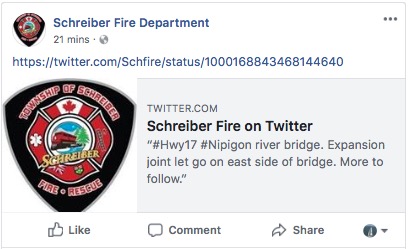
On Friday, May 25th, 2018, the Schreiber Fire Department tweeted at 8:25 p.m. that an expansion joint had let go on the east side of the bridge. At 9 p.m. they clarified, “The NE corner in the westbound lane has lifted. Traffic control is now in place, they will attempt to alternate traffic in the eastbound lane.” At 11:22 p.m. the word came, “The Ontario 511 website is saying the westbound lane re-opened circa 10:50 pm.”.
Annemarie Piscopo, Communications Coordinator for the Ministry of Transportation – Northwestern Region explained in an email to Wawa-news (Tuesday, May 29), that at approximately 8:29 pm on Friday, May 25th, the westbound lane of the Nipigon River Bridge was closed to traffic. This closure was to ensure the safety of both workers and drivers while crews carried out routine maintenance work at the temporary east expansion joint.
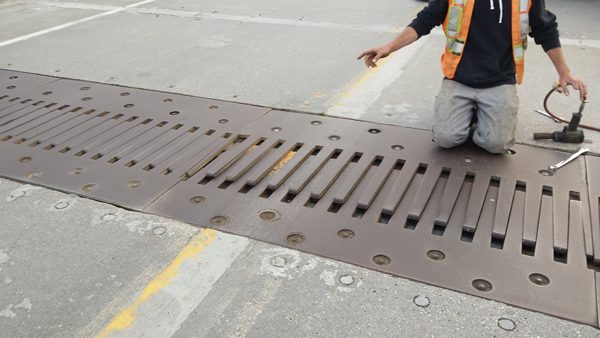
Photo credit – Ministry of Transportation, showing the temporary east expansion joint at the Nipigon River Bridge during the lane closure, and prior to maintenance work being completed.
Piscopo continued “Since the temporary expansion joint was installed in 2015, MTO has continuously monitored and tightened the joint. Tightening of the bolts in the temporary expansion joints is a routine maintenance activity.”
While the bridge was closed Friday evening, the plate was removed to clean and reset and the westbound lane was later reopened that evening at approximately 9:55 p.m. Piscopo stated, “The plates will be replaced with permanent joints later this year, as part of the bridge construction contract.” She continued, “The bridge is safe for the travelling public. There are no concerns with the bridge and the deck did not move or uplift in any way. Construction of the bridge is ongoing and we expect it to be fully open by the end of 2018.”
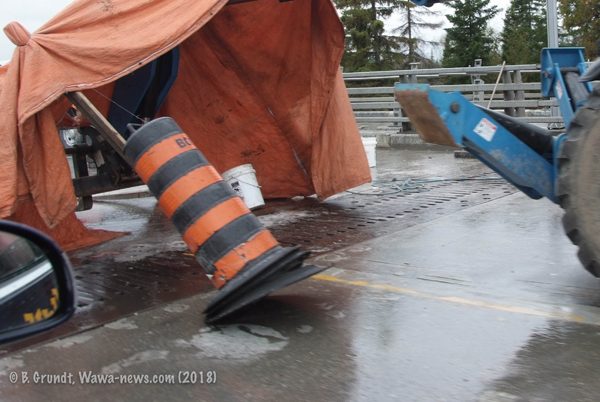
The area has been covered over with a tarp to protect the repaired area from rain (Saturday, May 26th, 3:14 p.m.)
Wawa-news went up to Nipigon the next day, Saturday, May 26th, and waited in line to cross the bridge. At that time, 3 p.m. the westbound lane was closed to traffic, and a worker was observed pouring a bucket of a greyish liquid at the finger joint. By the time I turned around and crossed back over the bridge, the pouring was completed, the bucket resting there, and the area covered with an orange tarp to shelter the repaired area from the rain. As I reached the west end of the bridge, traffic had returned to the westbound lane, and workers could be seen inspecting the finger joint on the eastbound lane entering the bridge.
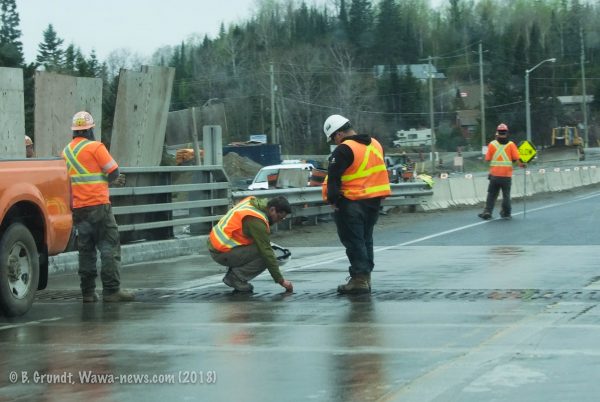
Workers inspecting the Nipigon River Bridge’s west end finger joint expansion plates (eastbound lane), (Saturday, May 26th, 3:15 p.m.).
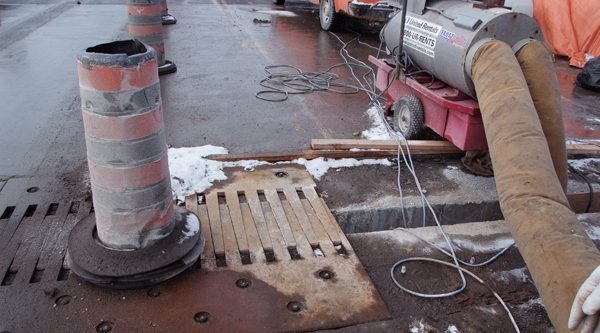
February 2016 – Westbound lane at the west end of the Nipigon River Bridge showing the gap between the abutment and the bridge that is covered by finger joint expansion plates.
An anonymous source to a Thunder Bay news website explained that the repair involved installing new anchor bolts in the temporary finger joint plates. The temporary finger joint plates will be replaced with thicker, more sturdy ones when the final coat of pavement is applied when the bridge is finished.
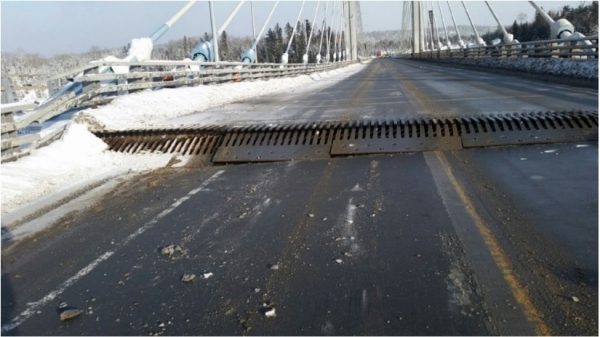
Figure 1-1: Nipigon River Bridge, 600mm uplift of the north bridge edge at west abutment, January 10th, 2016. (Associated Engineering, Nipigon River Bridge Independent Technical Review)
“On Sunday afternoon, January 10, 2016, the Nipigon River Bridge on Highway 11/17, a section of the TransCanada Highway across northwestern Ontario, became impassable following the complete fracture of all 40 bolts connecting the tie-down bearing to the main girder bottom flange on the north-west bearing of the bridge.” – Associated Engineering, Nipigon River Bridge Independent Technical Review. This failure crippled travel across Canada. The Nipigon River Bridge is a crucial link in trans-Canada travel.
Testing of the failed bolts was conducted by the National Research Council (NRC) and by Surface Science Western (SSW). The analysis by Associated Engineering revealed that a number of factors contributed to the failure (heavy but legally loaded trucks, out-of parallel bearing condition arising from the installation methods), including that the bearing design did not comply with the requirements of the contract. Associated Engineering concluded their report, “Bolt polish marks were also observed on the intact bolts of the centre bearing suggesting that it was also experiencing bolt bending and was prone to a fracture similar to the north-west bearing failure.”
Ministry of Transportation Highway Standards Branch Bridge Office Report stated it quite baldly, “The evaluation showed that the shoe plate, bolted connection between shoe plate and girder, bolted connection between shoe plate and bearing, and bearing design all failed to meet the requirements of the CHBDC.” Editor’s Note: CHBDC means Canadian Highway Bridge Design Code.
The Nipigon River Bridge was budgeted at $106-million. The repair work has been estimated at between $8 million and $12 million. Using Freedom of Information requests, The Canadian Press received project updates for May, June and October 2017 that referenced additional costs from construction challenges and delays – but with nearly all the amounts redacted. One additional cost estimate that hadn’t been redacted, detailed a repair to a floor beam between two girders that would add one month to the construction schedule and could cost up to $2 million. These documents also raised concerns with the east bearing which the contractor has repaired, but that the ministry has concerns with its long-term durability.
NDP transportation critic Wayne Gates has said that the public has a right to know the additional costs, and Progressive Conservative critic Michael Harris has said that negotiations about repair costs should have been done before the repairs began.
In October 2016, Professional Engineers Ontario (PEO) launched a Registrar’s Investigation to determine if any engineer practices caused the failure, and whether all work was done by the appropriate people and companies. This May, Engineering Dimensions reported that this investigation is continuing.
- Hwy 17 (Wawa to Batchawana) CLOSED - December 12, 2025
- Friday Morning News – December 12th - December 12, 2025
- Snow Squall Watch - December 12, 2025
 Wawa-news.com You can't hear the 'big picture'!
Wawa-news.com You can't hear the 'big picture'!
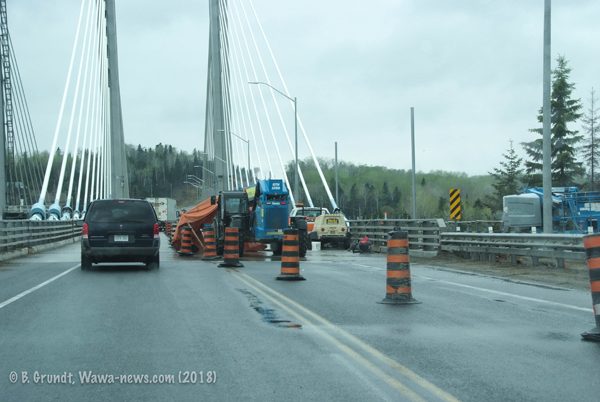

To Brenda Grundt, Editor, Wawa-news:
Your article of May 30, 2018 shows that MTO (Ministry of Transport Ontario) is in denial of the fact that there is a serious design fault in Nipigon River Bridge which resulted in the failure on January 10, 2016, (west end popped up) cutting Canada’s transportation System in two.
The present failure of May 25, 2018 (east end popped up) shows that the design fault has been exasperated by tying down the west end of the bridge.
Below are two sketches which explain what is going on:
This compares the Cable-Stayed design of the Nipigon River Bridge to a structure I designed in 1974, the Baxter Labs Theme Building. The tie-down cables were missed on the Nipigon design. The tie-downs recently installed on the west end of the bridge are a band-aid solution and are not solving the problem. Tying down the east end will not solve it either.
This sketch of the Baxter Labs Cable Stayed Roof shows the design of distributing the thrust away from the mast to avoid Euler Buckling (sudden buckling of the main bridge girders). Forty-four years later proves this design works.
Some Professional Engineer, competent in the design of structures, should take a look at this. There are a few left in Canada but they are getting older (Pat Quinn, Jim Fedorkiq, Roger Dalton (Order of Canada), etc.), and their work is fleeing to the US.
Michael Hogan, PhD, Structural Engineer.